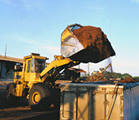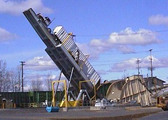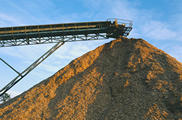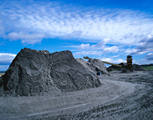| Biomass Fuel Transportation & Delivery |
 |
Typically, biomass power plants are built close to a
fuel source, because transporting heavy and bulky fuel is not economically
viable. If the power plant is within 1,000 to 1,500 feet of the fuel source,
then conveyors are usually used to bring the fuel into the power plant.
Beyond 2,000ft, the biomass is usually transported by truck or large,
front-end loaders. |
| One of the more interesting sights at a biomass power
plant is the truck-dumper. These large machines can lift an entire truck
& trailer, tilt it to over 60 degrees, and dump the contents of the
truck into the waiting storage facility. |
 |
| Biomass Fuel Storage |
 |
Biomass is bulky and requires large storage areas. Most
biomass fuel is used as soon as it is delivered, however some of the fuel
is usually stored outdoors in case of transportation problems. These stockpiles
are usually connected to the power plant through a series of conveyors. |
Boiler Feed System
Once the wood fuel is retrieved from the storage pile, it is usually processed
to make it more homogeneous. Rocks, stumps and other contaminants are removed,
and the fuel is fed into a shredder (or a 'hogger' if the fuel is pummeled
into smaller pieces). After the fuel has been prepared, it is much more uniform,
making handling, burning and disposal much easier. Conveyors are used to get
the processed fuel to the hopper sitting in front of the boiler.
There are several systems available for delivering the fuel
into the boiler:
- pushers,
- screw conveyors,
- pneumatic systems,
- gravity.
Biomass Boiler
A typical Biomass boiler has two functions:
- Combust (burn) the fuel;
- Produce steam.
In the Combustor section, fuel moves through three zones:
- Zone 1 - the fuel is dried;
- Zone 2 - the fuel is combusted (burned);
- Zone 3 - ash is removed into the ash handling system.
Hot combustion gases produced in Zones 1 & 2, pass by
rows of tubes filled with water. The energy in the hot gases turns the water
into steam (usually 600-1,200 psig and 800-900°F). The cooled combustion
gases are scrubbed of polluting particles, and then discharged to the stack.
| Ash Removal System |
 |
Just like in your fireplace, one of the byproducts of
wood-burning is ash. About 3% (by weight) of the biomass fuel is rejected
from the boiler as ash. This ash is conveyed from the boiler by screw
conveyors or drag-chain conveyors, and deposited in a bin or ash-holding
area. It is then trucked to a suitable landfill area. |
Combustion Gases Treatment
The combustion gases leaving the boiler contain some fly ash and soot. These
products are removed from the gases, before they are discharged into the atmosphere.
The three most common systems for removing these pollutants are: electrostatic
precipitators, baghouses, and wet scrubbers.
Smoke Stack
The design of the stack is usually governed by local regulations and the type
of scrubber used. Some stacks reach heights of 150-200 feet.
Steam Turbine/Generator
Steam from the boiler is converted into mechanical energy by the Steam Turbine.
The Steam Turbine is connected to the Generator, which converts the mechanical
energy into electricity. Only about 30-34% of the steam energy is converted
into electricity. The other 66-70% of the energy is rejected to the atmosphere
(or a nearby water body).
Condenser
The Condenser is basically a large dehumidifier. It cools the low pressure,
de-energized steam that comes out of the back-end of the steam turbine. Once
this steam has been cooled back into water, it is fed back into the steam
turbine to start all over again. The bigger and more effective the condenser
is, the lower the pressure at the back of the steam turbine. And the efficiency
of the steam turbine is dictated by the pressure difference between the front
and back of the turbine. So the Condenser dictates the efficiency of the steam
turbine.
The Condenser is basically another set of tubes filled with
cool water (from a nearby river, lake or cooling tower). When the steam makes
contact with the cooler tubes, it condenses back into water, which is pumped
back to be re-used.
Water Supply, Treatment and Boiler Feedwater
Water is used in almost every section of the power plant. Before it can be
used, it first must be de-mineralized and chemically treated to remove all
impurities. About 3-5% of the water used is lost in the process, and must
be restored from make-up water from outside the plant.
Now let's take a look at the natural gas Pipeline. |